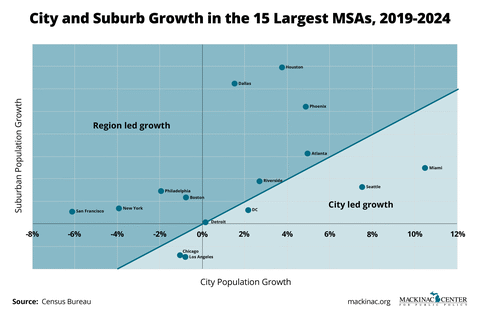Are cities or suburbs winning over more Americans since the pandemic? Lots of different choices go into the decision of whether to live in a major city or one of its suburbs. Some people enjoy the bustling lifestyle and easy commute of a city; others go for a detached home and a lawn of its suburbs. Throughout history there has been booms in both city and suburban growth. Yet cities and suburbs grew at roughly the same rate from 2000 to 2019, meaning that neither cities nor suburbs were more attractive. Since 2019, however, lots have changed. Suburbs pulled out ahead, but only by a bit.
Some core cities in the nation’s 15 largest metropolitan statistical areas gained population between 2019 and 2024, while others lost residents. The cities of New York and San Francisco lost the most. New York City’s population was down by 346,700 people, a 3.9% loss, and San Francisco was down 54,500 people, a 6.2% decrease. The fastest growing cities were Miami, which added 46,300 people, a 10.5% increase, and Seattle, up 54,700 people, a 7.5% increase.
The top-growing cities tended to have growing suburbs. The fastest growing suburbs were those in the Houston MSA, which added 659,600 people, a 13.9% increase, and those in the Dallas MSA, which added 779,100 people, a 12.5% increase. Houston and Dallas grew as well, but by smaller rates. The city of Houston grew by 86,600 people, a 3.8% increase and the city of Dallas increased by 19,800 people, or 1.5%.
The suburbs in Los Angeles and Chicago performed the worst among the suburbs in the 15 largest MSAs. The Los Angeles suburbs dropped by 279,600 people, a 3.0% decrease. Chicago’s suburbs were down 196,200 people, a 2.9% decrease.
The metro areas that added people tended to add people in both cities and suburbs. The places that lost people lost them in both cities and suburbs. In other words, it’s less about whether cities or suburbs are attractive, and more about which regions are the most attractive. They’ll have both growing cities and suburbs.
Each dot in the graph below represents a different metropolitan statistical area. The x-axis represents how much the core city’s population has changed while the y-axis represents change in the MSA’s suburbs. The line indicates where cities and suburbs would be if they grew at the same rate. The dots above the line indicate places where suburbs grew more than the city and the places under the line show where cities grew more than the suburbs.
Central cities have become slightly less important to the 15 largest MSAs. Their share went from 24.7% of the MSA’s combined population in 2019 to 24.1% in 2024. It’s a small drop, but it shows that the suburbs have been more attractive in recent years.
What has changed in the last 5 years? It could be a combination of a lot of things, but the COVID-19 pandemic is likely one large factor. Cities were harder places to be in when governors forced people to distance themselves from each other. Some benefits people get from being in cities, like shorter commutes, don’t pay off when workplaces are shut down.
Both cities and suburbs can grow if they do well at attracting people. That was true before the pandemic, and it’s true after the pandemic. Before the pandemic there was little change in the proportion of people who lived in the cities compared to the suburbs. Since then, even if it is small, there has been a change in that proportion, showing us that suburbs have been winning.













